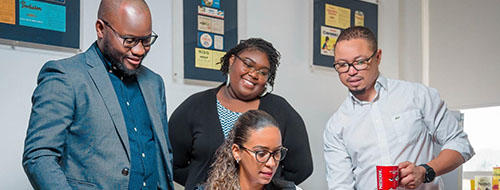Nestlé World Milk Day
Do you know your calcium ‘credit balance’?
Celebrate World Milk Day on 1 June by learning why your morning maas moustache is so important for leading a healthy lifestyle
Did you know that a perfect posture and a brilliant, white smile can be credited to an adequate amount of calcium in the body? Until we reach the age of twenty, we contribute between 100 and 150 mg of calcium every day to our bones. Our calcium ‘credit balance’ reaches its maximum when we hit the ages of between 25 and 30, after which time men and women’s calcium accounts steadily begin to drop.
“The good news is that your body can help to reverse the natural breakdown of bones through exercise and a calcium-rich diet,” says Nestlé Wellness Manager Naazneen Khan.
“If you’re between the age of 19 and 50, you should be getting around 1 000mg of calcium daily. By drinking a glass of milk or maas every day, eating two slices of cheese and a small container of yogurt, you have already met your daily calcium requirement. Or if you’re looking for plant-based foods, try including broccoli, kale, chard, hazelnuts and seeds in your daily diet.”
Have a look at Nestlé South Africa’s calcium chart below to ensure that you’re eating at least three portions of calcium rich foods daily:
| Milk, milk products and cheese | Amount of calcium contained |
|---|---|
| 1 glass of milk (1.5 % fat), 200 ml | approx. 246 mg |
| 1 container of yogurt (1.5 % fat), 150 g | approx. 185 mg |
| 1 slice of reduced fat cheese (45 % fat dry weight) 30 g | approx. 309 mg |
| Vegetables | |
| 1 portion of kale, 200 g | approx. 424 mg |
| 1 portion of fennel, 200 g | approx. 218 mg |
| 1 portion of broccoli, 200 g | approx. 176 mg |
| 1 portion of leeks, 200 g | approx. 126 mg |
| Nuts and seeds | |
| 2 tablespoons almonds, 20 g | approx. 50 mg |
| 1 container of yogurt (1.5 % fat), 150 g | approx. 185 mg |
| 2 tablespoons sesame seeds, 20 g | approx. 157 mg |
While milk and dairy products generally provide an inexpensive and accessible form of calcium that is well-absorbed, Naazneen emphasises that no single food contains all the essential nutrients the body needs to function well. Healthy bones need a well-balanced diet, incorporating a variety of minerals, vitamins and proteins from a range of different food groups.
A lesser known fact is that healthy bones also need exercise.
“When we exercise our muscles exert traction and pressure on the skeleton, which stimulates our bones to increase their mass,” explains Naazneen. “The more our bones can store larger amounts of calcium, the more sturdy and stable it makes them. And the more sturdy and strong our bones are, the more the natural breakdown of bone mass is reduced.”
For more helpful tips on how to adopt a healthy lifestyle, visit www.tastierhealthierchoices.co.za.
Notes to editors 1 June was declared World Milk Day by the FAO (the Food and Agriculture Organisation of the United Nations) because a number of countries were already celebrating a national milk day on or around this time. For more information, visit www.fao.org/economic/est/est-commodities/dairy/school-milk/13th-world-milk-day/en/
About Nestlé South Africa
Is a wholly owned subsidiary of Nestlé Switzerland. The company was formally registered in South Africa about 97 years ago. The first Nestlé products arrived in South Africa during the 1870s, and the company’s presence in South Africa was formally entrenched on 7 July 1916 when it registered as a company. In order to meet the demands of a growing country, local production started in 1927 with the purchase of the South African Condensed Milk Company Ltd factory in Donnybrook, and the Estcourt and Franklin factories. Nestlé South Africa also services neighbouring countries – Lesotho, Swaziland, Botswana and Namibia. Nestlé is committed to bringing consumers tastier, healthier choices in their product offering, and will continuously strive to become the leading Nutrition, Health and Wellness company.
